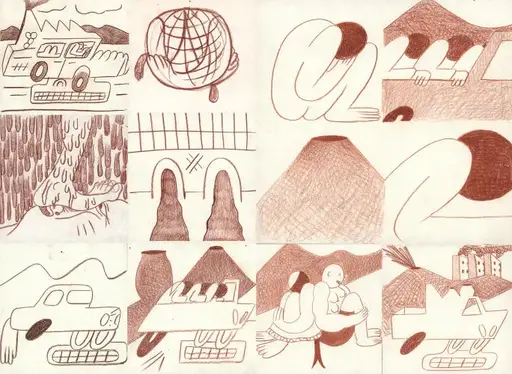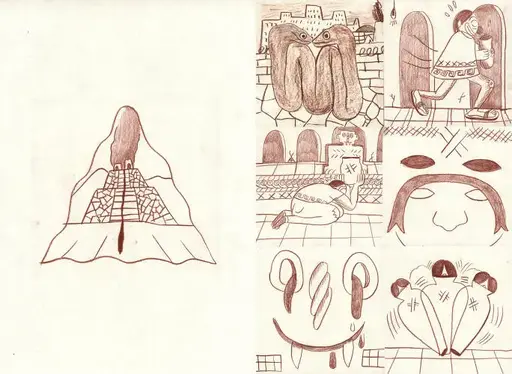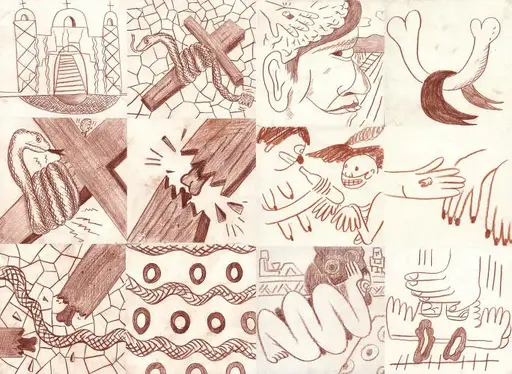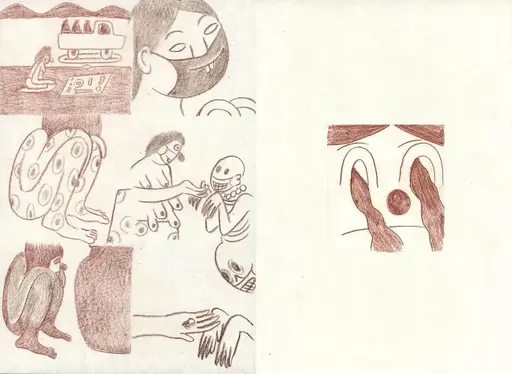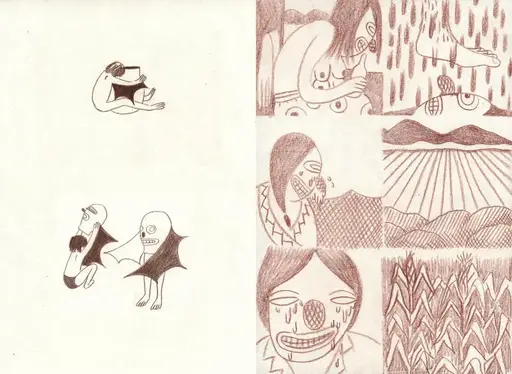Author(s)
Mariana Botey, Cooperativa Cráter Invertido
Mariana Botey’s text The State Is Coagulated Blood and Bones is written as a prologue to Cooperativa Cráter Invertido’s codex-comic Sangre Coagulada y Huesos (Coagulated Blood and Bones, 2021). The two contributions have been conceived in collaboration and are to be read in parallel, allowing for a mutual disruption of discourse and image.
Calendars and geographies might be misleading, but the morning born of these Latin American lands will not be the redeemers’ heritage, will not be a democracy full of statues and monuments, and bereft of people. On the contrary, it will be the work of the unredeemed, who will not be satisfied firing at clocks to arrest time . . .
Subcomandante Insurgente Marcos, De redentores e irredentos 1
This reading of Zapatismo runs counter to the undeniable and effective use that has been made of the phenomenon in reactivating a utopian imagination in circles of the progressive left. There are many Zapatismos, and undoubtedly the complexity of their repercussions is still scarcely evident. I’m here advancing an interpretation that emphasizes the revolutionary character of Zapatismo as an upending of temporality: “to make the continuum of history explode.” In De redentores e irredentos (Of Redeemers and Unredeemed), Spokesperson and Military Commander of the Zapatista National Liberation Army Subcomandante Insurgente Marcos riffs on thesis XV of philosopher Walter Benjamin’s “On the Concept of History”: “It will be the work of the unredeemed, who will not be satisfied firing at clocks to arrest time,” says Marcos. Benjamin gives an account: “In the July Revolution an incident occurred in which this consciousness came into its own. On the first evening of fighting, it so happened that the dials on clocktowers were being fired at simultaneously and independently from several locations in Paris.” I am reading the intertextuality across both texts as evidence of a messianic mode of address in the Zapatista reimagining of politics (fracture, myth, Other-temporality, revolutionary eschatology). The reflection of Marcos moving toward a disturbance of the figures of the redeemed as a counter-image of the history of the victorious seems to validate the understanding that Marcos is offering a deconstructive reading of the theses, as well as Benjamin’s messianic conceptualization of materialist historiography. Read vis-à-vis Marcos, “On the Concept of History,” illuminates how the indigenous rebellion fractures the continuum of history and exceeds the imagination of a European model of revolution: “they will not be satisfied firing at clocks to arrest time.” 2
The distinguishing characteristic of Zapatismo is its non-instrumentality. Its strategy is precisely to reduce tactics to an intervention into the space of social effervescence, into an economy of the gift and expenditure, with a rigorous insistence on non-accumulation (of power). Militant Zapatismo radically deconstructs revolutionary logic, which would usurp the father’s position, the space of authority, only to decree a new law. Such a challenge bewilders organic intellectuals. The Zapatistas’ inexplicable difference consists in aligning themselves with desire, and not with justice represented as a program assimilable to the civilizational model that has dominated history. Militant Zapatismo encapsulates itself within desire, and therein mounts its festival of rage: a war machine predicated on desire, on celebrating desire, on transforming it absolutely. Here, we are confronted with a mechanism in which rebellion exceeds revolution.
Normative stipulations, ruling over the theorization of democracy, presupposed reason as its essential and constitutive topos. Modernity is articulated and organized around a measure of rationality, and it is upon this ground that the notion of sovereignty is expressed as a project based in the struggle for autonomy—that is, in the formation and production of subjects that are created in a process of self-institution and self-limitation. As Mbembe points out in his critical essay “Necropolitics,” there are plenty of examples that impel us to rethink the problem of sovereignty, not as the struggle for autonomy, but rather as the “generalized instrumentalization of human existence and the material destruction of human bodies and populations.” 4
The historical circuits of operation, where the phenomenon of necropolitics appears constant and necessary, become transparent and obscene in the sphere of the colonial-postcolonial: “Colonial warfare is not subject to legal and institutional rules. It is not legally codified activity. Instead, colonial terror constantly intertwines with colonially generated fantasies of wilderness and death and fictions to create the effect of the real [emphasis added]. 5 It is not a coincidence that it is precisely through a rereading of Georges Bataille’s theorization of sovereignty that Mbembe advances his intervention into a logic that depicts coloniality and post-coloniality as the territorialization where exception provided the structure of sovereignty, as the space wherein “the fiction of a distinction between ‘the ends of war’ and ‘the means of war’ collapses.” 6
Mbembe advances the deconstruction of modernity’s romance of sovereignty from the localities of Africa and Palestine. In a similar gesture we could advance a localization via Mexico (or, to be more precise, the idea of Mexico). The critical task implies a reinscription of a colonial-postcolonial dimension into Bataille’s texts. Here we find a supplementary logic that operates in a discursive and aesthetic register, which identifies the production and regulation of death as a dispositif (device-war-machine) for political domination and historic ordering. Moreover, following the trace of the Aztec phantasmagoria that inhabits Bataille’s examples, we could intertwine a sort of disturbed genealogy (heretic history) where the idea of Mexico is prefigured as a reservoir of the cultural imaginary from which modernity has attempted a return to the multiplicity of confrontations of concepts of sovereignty that were taking place at its origins.
Both Bataille’s description and interpretation of the sacrificial economy of the Aztecs and poet Octavio Paz’s The Other Mexico: Critique of the Pyramid (1970) are examples of a textual weaving that, although radically divergent in their final movements, converge in illuminating a fissure. Bataille’s first explicit elaboration of the Aztec example occurs in “L’Amérique Disparue” (Extinct America), one of his earliest articles, published in 1928 as part of the catalog for the exhibition L’art Précolombien: L’amérique Avant Christophe Colomb. The chain of intertextual play upon which Bataille will elaborate his critique of classical and Marxist political economy returns to the Aztecs in his later work. In chapter one of La part maudite (The Accursed Share), the reinscription of the Aztec phantasmagoria propitiates the very structure of transgression that engenders a genealogy (heterology) of polyphonic examples for demolishing history by disturbing the synchrony of homologies that instrumental reason had warded as the academic expressive code of the European system of knowledge. 7 Paz’s The Other Mexico: Critique of the Pyramid, meanwhile, repeats the very movement of “production of knowledge” that Bataille unsettled in his critical annotation to Hegelian dialectics. Paz’s The Labyrinth of Solitude series is engaged in producing a “phenomenology of Mexicanidad,” a project that at its core is concerned with discerning an essence that “speaks the universal.” 8 Although he recognizes the presence of native culture as an internal (ghostly) Otherness that cannot be extirpated without mutilation, Paz writes—in his voice, as Mexico’s official poet of the Cold War—as if Mexico’s relation with the Indigenous was clearly officiating over an exorcism. Meant as a critical reading, the historical displacement that Paz attempts in his argument remains problematic: specifically, the fact that he transfers the very structure of violent domination to the moment prior to conquest and the imposition of colonial rule explicitly obscures the critique of modernity, the violence of the colonial process, and the destructive historical logic implicit in the expansion of capitalism. The source of the social dysfunction that is expressed in modernity has its origins in a mythical ancient history—the Spaniards are a second usurpation of a first usurpation: that of the Aztecs over the civilizing glory of Teotihuacán. All forms of Mexican power—from that point until the post-revolutionary regime that perpetuated the massacre of Tlatelolco—rotate under this sign.
The overlap between Bataille and Paz strongly suggests that the rational self-definition entailed by political economy and the doctrine of modernity enters a hiatus or cognitive failure in the case of Mexico, and in its paradoxical model of a temporality that connects past and present, life and death, politics and sacrifice. These metaphors engender and reflect uncanny doubles, sinister duplications, splinters of a modernity demented by the excess of ghosts that emanate from its historical formation. Under this scheme, necropower—as a core inscription in the social text of Mexico—appears as a reality that auto-generates and reproduces in historical cycles. We will be touching upon a discursive localization (emplacement) that erases (defaces) the limits of representation of violence and prefigures the tools for its critical deconstruction.
The gap that separates “the fiction of a distinction between ‘the ends of war’ and ‘the means of war’ collapses.” The building cracks open into a view of a zone of disturbance folded and doubled within modernity. What we are describing here is an operation of making uncanny that is engendered by a critical reading situated in the postcolony: a making uncanny that affects itself as the real. We are reading through colonially generated fantasies of wilderness and death and fictions to create the effect of the real. What is at stake is not an essence—as in Paz—that reified the consciousness of the radical Other that rotates outside of progress, the promise of democracy, and modernity, rather, what emerges is a blueprint of the colonial war machine as the motor of the capitalist system in its core logic of formation-expansion. This is what, according to Mbembe, Frantz Fanon described as the spatialization of colonial occupation working throughout a symbolic and psychic territorialization. 9
Thus, returning to contemporary art, we could propose the continuity of a radical poetic practice that emanates from this Other logic, and which we are here proposing and describing as an image of the postcolonial emerging as a zone of disturbance.
How fetishism can be described. A collective organism is made up of single individuals, who form the organism in that they have given themselves a hierarchy and a determinate leadership which they actively accept. If each of the single components thinks of the collective organism as an entity extraneous to himself, it is evident that this no longer exists in reality, but becomes a phantasm of the intellect, a fetish. . . . Moreover, it needs to be recognized that since a deterministic and mechanical conception of history is widespread (a common sense conception which is connected to the passivity of the great masses of people) each individual, when he sees that despite the lack of intervention something happens all the same, is lead to think that precisely above individuals there exists a phantasmagorical entity, the abstraction of the collective organism, a sort of autonomous divinity, which does not think with a specific head but which thinks all the same, which does not move with the legs of specific men but which moves all the same. 10
Gramsci identifies “an effective Jacobin force” as the political agency that defines the organization of the national-popular collective will, and considers this the foundational ethos of the modern states. Beyond a narrow European definition of this discussion, Gramsci’s description resonates with the Mexican case: “any formation of a national-popular collective will is impossible unless the great mass of peasant farmers bursts simultaneously into political life.” 11 From the nineteenth-century “Indian Jacobins” (Benito Juaréz and his radical left liberal circle), to the program of agrarian reform consolidated by Lázaro Cárdenas (1934–1940), the figure of Indigenous-Peasant as subject and agent of revolution mobilizes a myth that asserts itself in action and takes a concrete form. Such movements act as an uncanny force that splinters politics; which explodes from the concealed center of the very image and machinery of state power: “there exists a phantasmagorical entity, the abstraction of the collective organism, a sort of autonomous divinity.” 12
Today’s Mexicayotl (from the Nahuatl: Mexica-yotl, yotl meaning heart or essence) is an irredentist movement that spirals around a prophetic corpus that announces the rebirth of the pre-Hispanic under the sign of the Sixth Sun: a new age blazed by the return of Quetzalcoatl and the restoration of the mandate of Cuauhtémoc. Even as this narrative reflects and incorporates elements of the Mesoamerican traditions, it does so via the first generations of “Indian chroniclers” and informants compelled to translate and Christianize them after the Conquest. The resulting narrative is itself a construction authored by Spanish, criollo, and mestizo intellectuals in their search for historic signification.
This hybrid construction mourns, dissolves, and mystifies the violent logic of colonial trauma. Its nativistic intellectual drift hints at a double exoticism that unravels the nature and limits of anthropological discourse—a colonial discipline by definition—by affecting a displacement of the Other Indian, to the Other European/mestizo in in relation to themselves. It is, in other words, a double alterity where the exotic Other embodies the fantasy of what is the real and what is necessary in history: an acute and symptomatic manifestation that unfolds as a paradoxical transference of the indigenous alterity at the center of the nation’s symbolic universe.
Mexican anthropology (and its secondary effect in Mexican aesthetics) is in many senses a double construction—ambivalent in its relation with the close and diffuse nature of its object of investigation (the indigenous culture). This discipline has played a central role in the ideological construction of the nation-state, arguably to such an extent that the specific form of discourse that it has generated—Mexican Indigenismo—has not had the Indian, but the nation itself as its true and essential object. This ambivalent position toward the Other (the “Indian”); this fixing of the Other as an internal hidden signifier; and this twofold and phantasmagoric elaboration of an object has engendered a configuration of subject formation that is disjointed, parasitized by an object that continuously splits the subject of history from itself.
The Mexicayotl is then a secondary elaboration—a reinscription. Thus, by focusing on this phenomenon, what ensues is not an anthropological or historical narrative about the Other as “the reality” of indigenous culture. What actually transpires is a retranslation of another Other—the “Indian” as rooted in the symbolic and the imaginary, as a phantasmatic projection of the Mexicans that are not Indian, and as the site or structure of the fantasy of origins, nation, race, and the emergence of the national-popular.
in defiance of the logic that would keep humans entirely distinct from gods and unable to be superimposed one on the other. That is not the way with the Nahua mind, as far as one can grasp its way of working: favorably disposed to the most unexpected interpretations, combinations, associations and shifts in meaning—unexpected to the modern observer that is—it builds up meanings, versions, and images by accreditation. And reorders them according to the circumstances and context. Because they are “the covering, the bark, the skin” of the protective divine force [ixiptla] . . . 14
Thus, ixiptla is a complex concept that is translated as bark, skin, and envelope, but also as representative, delegate, and as covering or receptacle.
The phrase “baroque machine” is an allusion to Gruzinski’s important book Images at War (2001), which builds a meticulous historical argument about the formation of a complex apparatus of cultural appropriation and indigenous forms of negotiation and resistance starting in the colonial era. As an argument about the radical operations of a regime of images organized as “cultural appropriation and syncretic invention,” Cooperativa Cráter Invertido’s codex-comic Coagulated Blood and Bones (2021), draws specifically from Gruzinski. “[T]he systematic appropriation of the signs of Catholicism,” writes Gruzinski, “[is] a process that perfected their mastery over the object transformed into a divine vessel, penetrating its thickness, inhabiting it.” In the codex-comic, Catholocism here is swapped for secular modernity and a postcolonial dérive of the political doctrine of the nation-state. Gruzinkski continues,“or rather, it seems to abscond with the signifier-signified dichotomy: far from referring to some immaterial and inaccessible entity, the successive encasings—statue, cavity, ear of maize, kernel, blood—are themselves already god, as if the symbol and the symbolized were inextricably confused. Therefore, they are neither empty statues nor full images. 15
Here, Gruzinski is analyzing Antonio Pérez’s secular-religious insurrection on the outskirts of Puebla and Tlaxcala in 1761. It may be important to underscore that the cases Gruzinski examines flip the terms of today’s very narrow debate about the political valence of cultural appropriation: it is indigenous people who are the iconoclasts. Their practices of collective political power re-signify and make use of the religious images of Spanish domination in order to attack and subvert it; hence the notion of a paraliturgy, “a collective, ritual, artisanal activity.” 16
What is relevant here is to conceive of the problem as a dislocation in the epistemic field—that is, to trace a spectral diagram where power is organized by an entirely Other axiomatic. For the western institutional representation of power, its exercise is always expressed in law; this is a juridico-discursive conception of power that defines the prerogatives of the sovereign. Modernity and the project of the Enlightenment and the democratic state impose this juridico-discursive grid and seldom allow for a different imagination. Following López Austin’s description of the “Man-Gods,” Gruzinski advances a figuration of Indian power that exceeds the operations of representation, control, and repression:
Power was thus at one and the same time a dynamic (that of divine fire), an envelope, and a practice. There was no power without a body to receive it and practices to intensify it. It is thought that Nahua power could not be apprehended exclusively under the form of the repression that it practiced or by the articulation and exercise of a law. It could be, but it was also, and essentially, the person of the lord and the noble, the ritual word, the finery of dress, the sacred relics, the court rituals, the festive liturgies, and the spectacular resort of human sacrifice, which did not, as one might imagine, represent only the symbolism complementing, and accessory to, juridical and institutional thinking and practice, but also embodied the language and exercise of power. 17
Coagulated Blood and Bones reads as a radically secular paraliturgy of images—that is, a multiplicity and unfolding of the ixiptla: Rag-Flag; Vampires; Monsterother; Two-headed Serpent; Huey Tonatiuh; Temple; Tooth; The Ashamed One; Phantom Headdress; Tlāloc; Archaic Laughter; Van of Progress; Teporocho; Mask; Chacmool; Foot of Xipe; Specters; Orca; Pollinating VampGirl; Mountain Deity; Milpa; Ejido; Redware Mask; Don Money; Presxs; White Cube; Portals; Thresholds; Fantomas’s Knife; Broken Cross; Cuauhtémoc; Bones; Faces; Black Ball; and Petate. A succession of fragments and splinters, recounting images of the dialectic of nation-state. Coagulated in stasis, suspended in a present-future tense. Exit [Reload] StateCraft toward a multiplicity of fragmented futures.
1 Subcomandante Insurgente Marcos, “De redentores e irredentos, ponencia del SCI Marcos, 16 de julio,” words of the Zapatista Army of National Liberation (EZLN) at the roundtable Latin America Seen from the Other Campaign, National School of Anthropology and History (ENAH), Mexico City, 16 July 2007, http://enlacezapatista.ezln.org.mx/2007/07/16/de-redentores-e-irredentos-ponencia-del-sci-marcos-16-de-julio/. Translation by author.
2 Insurgente Marcos, “De redentores e irredentos”; Walter Benjamin, Selected Writings. Vol. 4: 1938–1940, ed. Michael W. Jennings (Cambridge, MA: Harvard University Press, 2003), p. 395.
3 The notions of “necropolitics” and “necropower” must be understood as a critical development that builds from Michel Foucault’s fragmentary analysis of “biopolitics” or “biopower.” In his book, Homo Sacer: Sovereign Power and Bare Life, Giorgio Agamben illuminates the extent to which the notion of sovereignty as power over “life” is implicit in the history of western thought and to which degree this definition is in turn determined by the idea of the sacred and its intrinsic relation to prohibition (taboo). In the context of our discussion what is relevant is the identification of the colonial sphere as the exemplary case of sovereignty as the state of exception: Agamben establishes a direct relation that connects a state of emergency linked to colonial war to the creation of the concentration camp and experiments that extend it to the entire civil population. The critical implications of his central thesis imply a hidden matrix that connects these forms of political control, and the nomos (law) of modernity. See Giorgio Agamben, Homo Sacer: Sovereign Power and Bare Life, trans. Daniel Heller-Roazen (Stanford: Stanford University Press, 1998).
4 Achille Mbembe, “Necropolitics,” Public Culture 15, no. 1 (2003), p.13.
5 Mbembe, “Necropolitics,” p. 25
6 Mbembe, “Necropolitics,” p. 25.
7 Georges Bataille, The Accursed Share: An Essay on General Economy, Volume 1: Consumption, trans. Robert Hurley (New York: Zone Books, 1991), p. 46.
8 Octavio Paz, El Laberinto De La Soledad-Postdata-Vuelta Al Laberinto De La Soledad (Mexico City: Fondo de Cultura Económica, 1999), p. 305. Translation by author.
9 Mbembe, “Necropolitics,” p. 26.
10 Antonio Gramsci, The Gramsci Reader: Selected Writings 1916–1935, ed. David Forgacs (New York: New York University Press, 2000), pp 240–241.
11 Gramsci, The Gramsci Reader, pp. 243–244
12 Gramsci, The Gramsci Reader, p. 244
13Alfredo López Austin, Hombre-Dios: religión y política en el mundo náhuatl, Serie de Cultura Náhuatl (Mexico City: Universidad Nacional Autónoma de México, 1989), pp. 118–119. Translation by author.
14 Serge Gruzinski, Man-Gods in the Mexican Highlands, trans. Eileen Corrigan (Stanford: Stanford University Press, 1989), p.44.
15 Serge Gruzinski, El poder sin límites: Cuatro respuestas indígenas a la dominación Española, (Mexico City: Instituto Nacional de Antropología e Historia, 1988), p. 171. Translation by author.
16 Gruzinski, El poder sin límites.
17 Gruzinski, El poder sin límites.
Related


The modern nation-state is supposed to be ethnically and culturally homogenous; after World War II, both Israel’s implementation of Zionism and Arab Nationalism adopted versions of this purism—purging and excluding from the body social what refuses assimilation.

As part of FORMER WEST: Documents, Constellations, Prospects, 18–24 March 2013 at Haus der Kulturen der Welt, Berlin, art critic, poet, and curator Ranjit Hoskote convened a forum on “Insurgent Cosmpolitanism” with cultural theorists and artists whose work addresses and performs the insurgent cosmopolitan condition.

Mariana Botey’s text The State Is Coagulated Blood and Bones is written as a prologue to Cooperativa Cráter Invertido’s codex-comic Sangre Coagulada y Huesos (Coagulated Blood and Bones, 2021). The two contributions have been conceived in collaboration and are to be read in parallel, allowing for a mutual disruption of discourse and image.
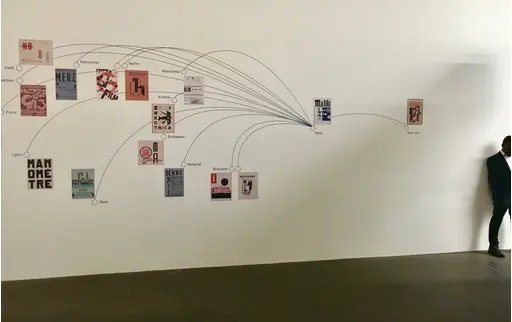
Long weaponized in the service of capital by the agents of neoliberalism, the nation-state is once again upheld as the bulwark of a white ethnos, securing privilege against migrants and immigrants, and against other nation-states in relations of neocolonial dependence.

From: New World Academy Reader #5: Stateless Democracy, Renée In der Maur and Jonas Staal in dialogue with Dilar Dirik, eds. (Utrecht: BAK basis voor actuele kunst, 2015), pp. 27–54

From: Once We Were Artists, Maria Hlavajova and Tom Holert, eds. (Utrecht: BAK, basis voor actuele kunst and Amsterdam: Valiz, 2017), pp. 32–52

In 1970–1971, Guyanese radical historian and anti-colonial activist Walter Rodney gave a series of lectures on the historiography of the Russian Revolution at University of Dar es Salaam, Tanzania. Inspired by C. L. R. James’s historical work on the October Revolution, Rodney set out to reveal the parallels between the problems confronting the postcolonial regimes in Ghana and Tanzania, and those that the Bolsheviks faced in building the Soviet state.

The video The Cut, The Punch, The Press (2021) is assembled from filmed fragments of a collection of 65 banknotes of the CFA franc, circulated between 1945–2021.



